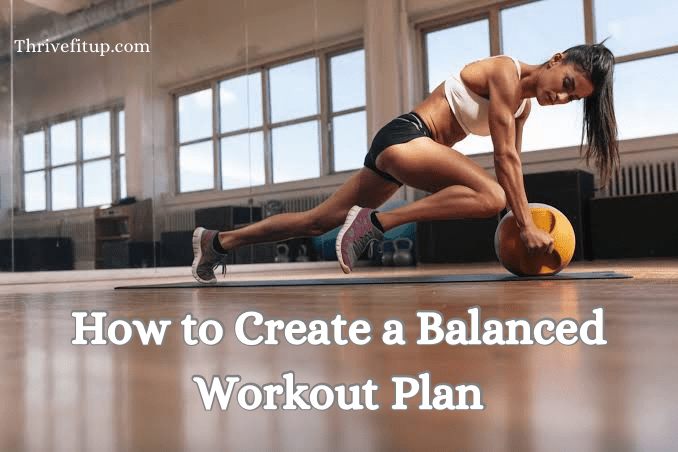People need to come up with a balanced workout plan in order to achieve and maintain their best form. Daily practice of exercise not only enables you to gain better health but also offers a better mood, quality sleep, and health in general.
To get the most out of your training program, it is therefore important to train in equal proportion incorporating cardio activities, strength activities, stretching activities, and recovery sessions.
Changing from this general knowledge base, let us go through a sample seven-day exercise plan to develop a viable fitness regimen.
How to Create a Balanced Workout Plan for Optimal Results
Warming Up and Cooling Down
To minimize the chances of a crash and to ready your body for movement, take 5-10 minutes before each session to warm up. Other dynamic stretches such as high knees and buttock kicks are suitable for circulation and decreasing stiffness at joints. After a workout treatment, include cooling down by stretching the muscles or taking a walk in order to see your pulse reduce.
Upper/Lower Body Splits
This plan incorporates four muscle-strengthening sessions: The recommended amount of training for the muscles of the upper and lower parts of the body is four sets each, per week. Do not change the workout routine often and then vary the weights and repetitions as you progress through the workouts.
Progressive Overload
Progressive overload refers to a set of programs where the muscles are gradually increased using weight or reps. Perform each exercise through all three sets of 10 repetitions, with only one minute rest between the sets. Toning the weights according to the level of fitness will make certain that the muscles are put under some decent resistance.
Stretching
When it is spoken of flexibility, is important because it helps to preserve mobility in the joints and avoids traumas. Make use of flexibility before and after exercises to enhance the muscle’s flexibility. Some effective stretches include:
- Calf stretch: Put your toes on any wall and bend your upper body to reach it.
- Hamstring stretch: Clasp one knee and lay down, elevating one leg perpendicular to the floor and the wall.
- Hip flexor stretch: Interlock your arms and fall into it with one leg forward and shift your hips.
- Shoulder stretch: Stretch one hand over your neck and hold it with the other hand.
- Quad stretch: Grab your ankle with your hand and then drag your heel back toward your butt.

Daily Workouts
Day 1: Looking to kick start your week with an amazing cardiovascular workout?
Cardio exercises are a perfect way to initiate your working week. They are good for the heart and can increase lung capacity and also they help to control mood swings since they release endorphins. Cardio also helps shed calories and improve stamina which makes it easier to perform day-to-day activities in the future.
- Examples: Walking, jogging, swimming, biking, aerobic dancing for example, stepping, or hiking.
- Moderate: Exercises in which you can talk but cannot sing (e.g., power walking).
- Vigorous: Exercises where speaking becomes an issue (such as cycling, or high-intensity interval training).
Tip: Check your pulse to get the appropriate intensity for moderate (50-70% of your maximum) and vigorous (70-85% of your maximum).
Day 2: Dumbbell Lower Body Workout- Build a Strong Base
Lower body strength is one of the significant components of health, coordination, stability, and postural control in our body. The exercises emphasizing compound movements such as squats, lunges, and deadlift mainly works on the hamstring, glute, quad, and calf muscles.
Benefits:
- Increases calorie elimination because many huge muscle groups are involved.
- Improve physical coordination and training for the athletes and good posture.
Exercises:
- Deadlifts: Involve your back, abdomen, and your legs during weight training.
- Lunges: Increase stability and tone the specific muscles of the lower limb, namely the glutes and quads.
- Squats: Follow exercise 2 along with leg power to strengthen your thighs and hips.
Tip: Be careful not to gain weight as much as shapes are formed to avoid getting injuries. When you begin, use little resistance, but as your muscles gain strength, incorporating more resistance into the regimen is advisable.
Day 3: Three Exercises: Sculpt Your Upper Body and Core
Today’s focus is the muscular endurance in your arms, shoulders, chest, and your abdomen. Being strong above enhances every day’s core activities, while a stable core reduces sagging and supports balance.
Exercises:
- Bicep Curls: Make your biceps and triceps stronger for the pulling muscles.
- Chest Presses: Strength to allow one to lift weights during chest and arms building.
- Planks and Russian Twists: Build basilar strength of core endurance and rotational strength.
Tip: Control your movement and emphasize contraction of the muscles working on any particular exercise.
Day 4: Recharge with Active Recovery
Low-impact exercises are recommended as an active recovery means of improving blood circulation and decreasing muscle stiffness without stressing the body.
Examples:
- Yoga for flexibility purpose with relaxation.
- Stroll for circulation – e.g. walking or swimming very lightly.
Benefits:
- Reduces muscle soreness.
- It increases mental health status and recovery from stress.
Tip: Listen to your body. In case the child feels very tired he should not engage in physical activities at all, but rather rest.
Day 5: Goblet Squat: Glute Power, Lower Body Strength
Targeted training of the glutes helps in the development of posture and the formation of a powerful athletic bulk of the posterior chain that helps athletes.
Exercises:
- Hip Thrusts: Build up glute building and enhance the dimension of hip extension.
- Single-Leg Deadlifts: Develop symmetry and/or improve the activity of leg muscles.
- Clamshells with Resistance Bands: Contraction of the glutes muscles is useful before lifting heavierweights.
Tip: Begin with movements that don’t require weights or opt for cheap, small resistance bands, and then work up to the ones that do.
Day 6: Improve Your Back and Shoulder Muscles by Training Your Upper Body
A strong back and shoulders are fundamental to good posture and protect functional motion that may be compromised in daily activities.
Exercises:
- Lat Pulldowns: Strengthen your back muscles.
- Dumbbell Rows: Heal the strained muscles and tendons of the shoulder girdle while enhancing the force with which you can pull.
- Shoulder Presses: Develop overhead pushing structural power.
Tip: To accomplish these benefits and to avoid imposition on the back muscles, it is important that during these exercises, one avoids rounding the shoulders and spooning the back.
Day 7: Rest and Reflect
The last day is meant for the rest in order that the muscles and energy get the opportunity to restore and develop. Something like stretching or light aerobics can also go a long way towards reducing the soreness and getting the body ready for the next week’s workouts.
Options:
- Some light exercises to enhance flexibility;
- Resting to get a reserve of energy that would be needed for the other activities during the following day.
Tip: This is a perfect day to measure your accomplishments, revise your goals, and be in a position to start another week of productivity.
Frequently Asked Questions (FAQs)
Should I Diet with my Workout plan?
Yes. Be sure to eat the right food and take a lot of proteins, good fats, and complex carbohydrates for your energy source.
How many times per week should I work out?
At least 150 minutes of moderate-intense physical activity per week and more than two sessions of muscle-strengthening activities.
Are warm-ups and cool-downs necessary, or can I avoid them?
Unfortunately, skipping these raises your chances of getting injured and decreases exercise efficiency.
What is progressive overload?
In progressive overload, one is required to add resistance training in the form of weight or repetitions to call for the development of muscles.
How can I encouraged to exercise?
Get activities that are interesting for you, exercise in groups, and write down your results for motivation.
Conclusion
Constructing a well-composed workout program involves this Cardiovascular workout, strength exercise, stretching, and recovery exercise.
It is safe to say that maintaining a schedule similar to this 7-day program will assist in creating a better routine and building up your fitness level to meet your objectives.
Get fit through exercising, list down an eating plan, monitor your development, and remain enthusiastic permanently.
